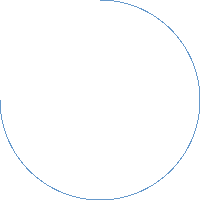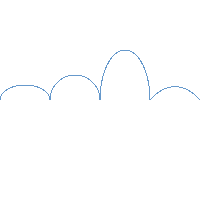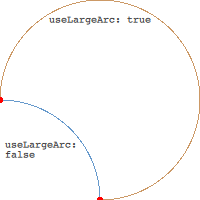C
PathArc QML Type
Defines an arc with the given radius. More...
| Import Statement: | import QtQuick |
| Since: | Qt Quick Ultralite 1.8 |
Enumerations
Properties
- direction : Direction
- radiusX : real
- radiusY : real
- useLargeArc : bool
- x : real
- xAxisRotation : real
- y : real
Detailed Description
PathArc offers a simple way to define an arc that ends at a given position and uses the given radius. It's design is based on SVG's elliptical arc command.
The following QML produces the path shown below:
|
Note: You must also link the Qul::Shapes module library to your project. For more information, see Qt Quick Ultralite Shapes QML Types.
In the earlier snippet, you can see that a single PathArc is not enough to define a circle. You need at least two PathArc items, each defining one half of the circle.
See also Path, PathLine, PathQuad, PathCubic, and PathSvg.
Enumeration Documentation
Direction |
Provides a list of direction options for the arc.
| Constant | Description |
|---|---|
PathArc.ClockWise | Renders the arc clockwise |
PathArc.CounterClockWise | Renders the arc counter-clockwise |
Property Documentation
Defines the radius of the arc.
The following QML demonstrates how different radius values can be used to change the shape of the arc:
| import QtQuick import QtQuick.Shapes Rectangle { width: 350 height: 350 Shape { ShapePath { startX: 0; startY: 100 strokeColor: "skyblue" PathArc { x: 50; y: 100 radiusX: 25; radiusY: 15 } PathArc { x: 100; y: 100 radiusX: 25; radiusY: 25 } PathArc { x: 150; y: 100 radiusX: 25; radiusY: 50 } PathArc { x: 200; y: 100 radiusX: 50; radiusY: 100 } } } } |
Note: You must also link the Qul::Shapes module library to your project. For more information, see Qt Quick Ultralite Shapes QML Types.
direction : Direction |
Defines the direction of the arc.
useLargeArc : bool |
Whether to use a large arc as defined by the arc points.
Given fixed start and end positions, radius, and direction, there are two possible arcs that can fit the data. useLargeArc is used to distinguish between these. For example, the following QML can produce either of the two illustrated arcs below by changing the value of useLargeArc.
| import QtQuick import QtQuick.Shapes Rectangle { width: 350 height: 350 Repeater { id: repeater model: 2 Shape { ShapePath { startX: 0; startY: 100 strokeColor: index === 0 ? "brown" : "skyblue" PathArc { x: 100; y: 200 radiusX: 100; radiusY: 100 useLargeArc: index === 0 ? true : false direction: PathArc.Clockwise } } } } } |
The default value is false.
Note: You must also link the Qul::Shapes module library to your project. For more information, see Qt Quick Ultralite Shapes QML Types.
xAxisRotation : real |
Defines the rotation of the arc, in degrees. The default value is 0.
An arc is a section of circles or ellipses. Given the radius and the start and end points, there are two ellipses that connect the points. This property defines the rotation of the X axis of these ellipses.
Note: The value is only useful when the x and y radius differ, meaning the arc is a section of ellipses.
Available under certain Qt licenses.
Find out more.




